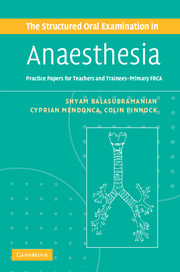SOE 7
Published online by Cambridge University Press: 21 January 2010
Summary
Key topics: renal physiology, exercise, neuromuscular junction
Q1 Renal physiology: renal blood flow/glomerular filtration rate
What is the normal renal blood flow (RBF)? How is it distributed?
The kidneys receive 1000-1250 ml of blood per minute, which is 20-25% of total cardiac output. The renal cortex gets about 500 ml/min/100 g. The outer medulla receives 100 ml/min/100 g and the inner medulla receives 200 ml/min/100 g.
Can you describe in detail the arrangement of blood vessels in the kidney?
Renal artery → Interlobar artery → Arcuate arteries → Interlobular arteries → Afferent arterioles.
The renal artery is a direct branch of aorta that enters the kidney at the hilum. It branches to form interlobar arteries, which in turn branch to form arcuate arteries. As the name implies arcuate arteries have a curved course and run along the boundary between the cortex and medulla. The interlobular arteries branch at right angles from the arcuate arteries from which the afferent arterioles finally emerge.
The glomerulus contains a tuft of capillaries. These capillaries are unique in that they originate from arterioles and also drain to arterioles.
The efferent arterioles branch to form the peritubular capillaries that surround the tubules. They also give rise to vasa recta, which play an important role in countercurrent exchange.
The capillaries drain into the renal vein, which leaves the hilum of kidney.
- Type
- Chapter
- Information
- The Structured Oral Examination in AnaesthesiaPractice Papers for Teachers and Trainees, pp. 149 - 173Publisher: Cambridge University PressPrint publication year: 2006



